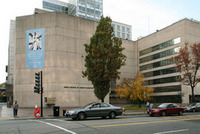Tear down Third Church or I will, judge tells DC
While one judge railed against misconduct in the prosecution of Senator Ted Stevens on Tuesday, another judge in the courtroom next door sharply rebuked the DC government for its refusal to let the Third Church of Christ, Scientist at 16th and I raze their aging, concrete, historically landmarked building.
Federal Judge James Robertson made it clear that he believes the landmark designation of the church imposes a burden in conflict with the federal RLUIPA statute. He denied DC’s motion to dismiss and all but promised that if Office of Planning Director Harriet Tregoning, the “Mayor’s Agent” on the administrative appeal, doesn’t rule for the church and grant them permission to tear down their building, he will in a “hundred page decision” that wades into the First Amendment “thicket”.
Most expect Tregoning will do just that. In a very unusual move, she presided over the case personally instead of delegating the job to the typical administrative law judge. Ruling that Third Church’s building imposes financial hardship, due to the expense of heating and lighting the concrete structure, the difficulty of maintenance, and other burdens would get rid of the case without creating a potentially dangerous precedent exempting religious bodies from their obligations to preserve other, more historically worthy buildings.
Robertson has earned himself a no-nonsense reputation. After promptly throwing out the lawsuit challenging President Obama’s citizenship, he asked the plaintiff’s attorneys to justify why their suit wasn’t frivolous and harassing and why they shouldn’t pay back the President for his own legal fees. Robertson is also the judge who resigned from the FISA court in 2005 with a sharply-worded letter criticizing the constitutionality of the secret court.
The judge made his opinions on this case clear right away. ANC Commissioner Mike Silverstein, a supporter of the church’s position, sent this synopsis of one exchange, with Robertson questioning DC’s counsel Leah Taylor.
“Have you seen the church?” Judge Robertson asked … “Yes, your honor,” she replied.
“Been down there? Walked around? Seen the building?” he continued. “Yes, your honor,” she replied.
“Gone inside?” he asked. “No, your honor,” she replied.
“Couldn’t find the door, could you?” he shot back with a gleam in his eye and a wicked smile.
The left side of the courtroom, filled with members and backers of the church, erupted with laughter. The right side, where the preservationists were sitting, heard a few nervous chuckles.
One of the biggest urbanist arguments against the building is the position of the door, in a courtyard on the opposite side from the corner. Blank walls face I Street and the portion of 16th closest to the corner. A fire door does open onto I, and according to church officials, confused visitors often try to knock on that door.
But the issue before the court is whether landmarking the structure violates the church’s First Amendment rights. And according to Silverstein, Judge Robertson clearly signaled his willingness to overturn the Metropolitan Baptist Church case holding that landmarking of a church does not pose a “special burden”. Robertson also criticized the HPRB hearing which denied the raze permit, where Chairman Tersh Boasberg dismissed First Amendment issues as being beyond the scope of the Board’s purview. “I am very troubled that the District refused to even entertain assertions of violations of First Amendment, RLUIPA and RFRA rights,” Robertson said.
This is a great test case for those eager to curtail preservation and a terrible case for preservation itself. The preservation community will benefit most if they lose this case in the Mayor’s Agent hearing so that they don’t lose the broader case in court.

